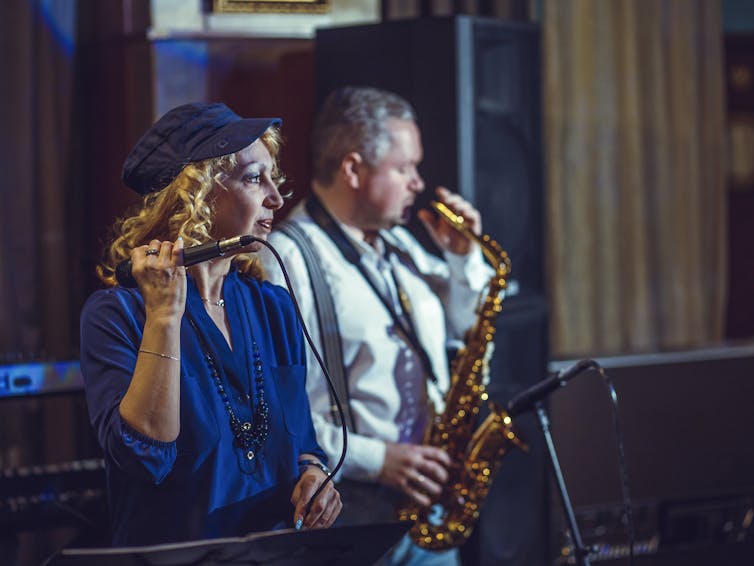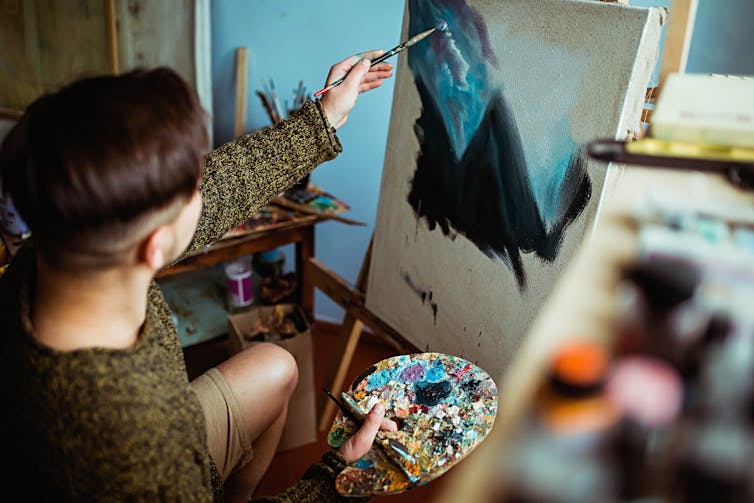The gender pay gap is wider in the arts than in other industries
- Written by David Throsby, Distinguished Professor of Economics, Macquarie University
Australian artists now spend more time on their creative practice than in previous years but earn less from it. The situation is particularly gloomy for the average Australian female artist. She is better educated than her male counterpart, she spends about the same time on creative work as he does, yet she earns a much lower income from it – $15,400 versus $22,100 in the 2014-15 financial year.
Indeed, the income gap between men and women is wider in the arts than the average gap across all industries in Australia. This gap appears to be especially evident for female writers, visual artists and musicians.
These data come from a major survey of practising professional artists in Australia that we have carried out over the past year. It’s the most recent in a long series of surveys undertaken in the Economics Department at Macquarie University since the early 1980s with funding from the Australia Council. The accumulated results tell us a lot about how the conditions of professional arts practice have changed over the years.
Our survey shows that the average income Australian artists earned from creative work is now just $18,800 a year, which is less in real terms than for any of the previous survey years. This is less than they could earn in other professional occupations that require similar educational qualifications. Their total gross annual income including all sources of income is $48,400.
One of the hazards that professional artists face throughout their career is having to explain why they should be paid for doing what others do for fun – painting, making music, acting, dancing, writing poetry.
People often don’t appreciate that the level of education, training, experience and skill required to become a professional are at least as rigorous in the arts as they are in other professions like medicine and the law. In fact, the great majority of professional artists (90%) have post-school qualifications compared with only 53% for the general labour force. Artists spend about six years in training to obtain their basic qualifications, then almost another four years to receive further ones.
 The great majority of artists have post-school qualifications.
shutterstock
The great majority of artists have post-school qualifications.
shutterstock
There are just under 50,000 professional artists in Australia. Since the genders are split in roughly equal proportions, the average or “typical” artist could be male or female. She or he is likely to be aged around 49 years, born in Australia, living in one of the capital cities, married or living with a partner, and without dependent children.
A ‘portfolio’ career
Artists are multi-talented. At some point in their lives they will have engaged in some other form of original creative work beyond their principal artistic occupation. Indeed the majority of artists today follow a “portfolio” career, working as freelancers under various contractual arrangements, often spanning multiple artforms, and applying their creative skills from time to time in industries far removed from the arts.
Less than a quarter of all artists are able to pursue their original creative practice full-time. We find that 66% of artists would like to spend more time at their creative work. The most important reason why most cannot do so is because working in the arts does not pay well enough, and they need to earn more income elsewhere.
 Less than a quarter of artists are able to pursue their practice full-time.
Violetta Nahachevska/shutterstock
Less than a quarter of artists are able to pursue their practice full-time.
Violetta Nahachevska/shutterstock
Why do so many aspirants long to take up a career in a field that offers so little prospect of financial security? Clearly one reason is the non-pecuniary rewards to be derived from art practice – what economists call, rather quaintly, “psychic income”.
The inner drive to make art is what encourages artists to continue. When asked what have been the most important factors that have contributed to advancing their careers, 23% of artists nominate hard work and persistence, and 21% point to their passion, self-motivation and self-belief.
The average artist works a 45-hour week, not including hours spent on unpaid activities such as studying or voluntary work. Yet although creative work absorbs 57% of artists’ working time, it generates less than 40% of their income. More than three-quarters of all artists have to take another job to support their creative practice.
These additional sources of income may be found within the arts sector – visual artists teaching in art school, for example, or dancers or musicians taking private pupils – or employment may have to be sought outside the arts altogether.
Why the income decline?
Why have artists’ incomes declined? Could it be due to a sudden increase in their numbers, or perhaps a decrease in support provided to them? Neither explanation is convincing – though total numbers of artists have risen since 2009, the increase is comparable with the growth in the Australian labour force as a whole. And, while it appears that more artists have been applying for financial assistance in recent years, the success rate is similar to before.
Although we cannot answer the above question fully, the data point to the extent to which genuine creative activity is being curtailed by circumstances over which artists have no control. This should continue to be of concern for public policy – if the market does not adequately recognise the contribution that artists make to the cultural life of this country, some financial intervention may be warranted to rectify the inequity.
What of the future? The accumulated results from this series of surveys have helped us over the years to comprehend more clearly why we as a society need to accord artists the respect they deserve as professionals.
An understanding of the conditions of professional arts practice is a prerequisite for the development of more effective measures to support individual artists and to nurture the growth of the arts. At present, such measures are needed more urgently than ever.
Authors: David Throsby, Distinguished Professor of Economics, Macquarie University
Read more http://theconversation.com/the-gender-pay-gap-is-wider-in-the-arts-than-in-other-industries-87080



